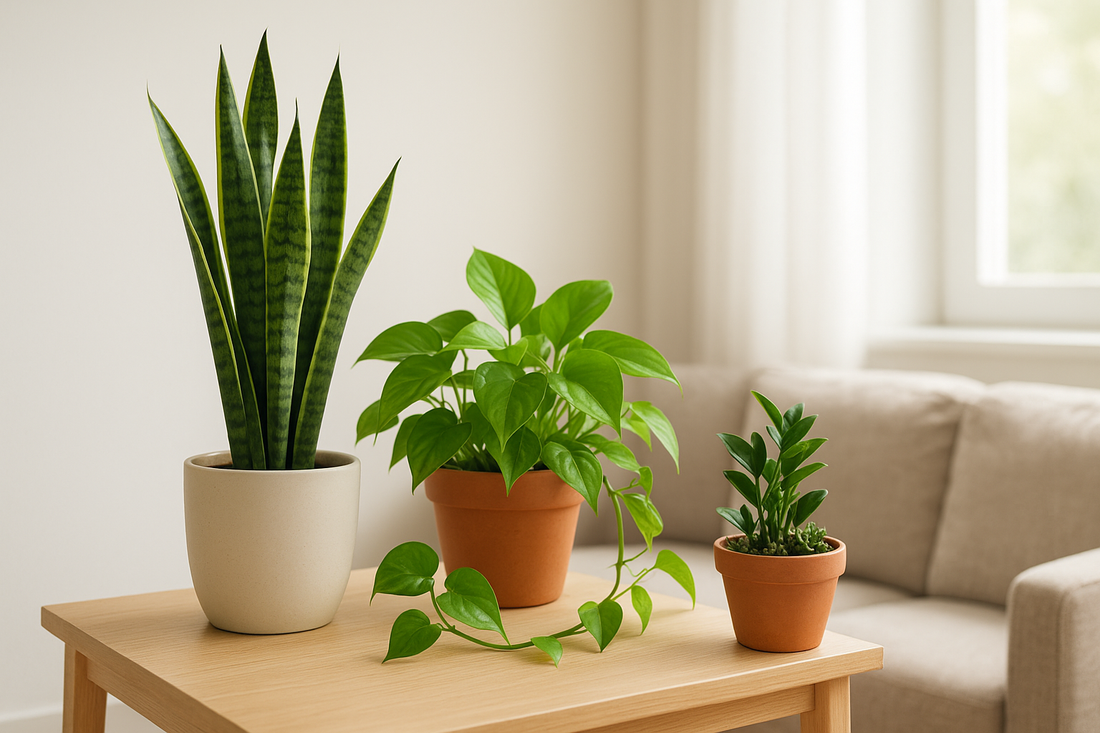
Top 10 Low-Maintenance Plants for Thriving Greenery (and How to Care for Them)
Do you dream of a home filled with lush, vibrant greenery but are haunted by the ghosts of plants past? You're not alone. Many people believe they have a "black thumb," destined to kill any plant they touch. The good news? It's not you; it's the plants you've chosen. The secret to a thriving indoor jungle isn't a magical green thumb—it's starting with easy, forgiving, low-maintenance plants.
These botanical superheroes are built to withstand a little neglect, inconsistent watering, and less-than-ideal light. They're the perfect companions for busy professionals, frequent travelers, and anyone new to the world of plant parenthood. This guide will walk you through the top 10 hard-to-kill houseplants and provide the simple care tips you need to help them flourish. Get ready to transform your space and your confidence! 🌱
1. Snake Plant (Sansevieriatrifasciata![]() )
)
Often called "Mother-in-Law's Tongue," the Snake Plant is the undisputed champion of low-maintenance greenery. With its striking, upright leaves and air-purifying qualities, it’s as beautiful as it is resilient. It's one of the best beginner plants you can find.
- Why it's low-maintenance: It thrives on neglect! This plant is highly drought-tolerant and can survive in almost any light condition. It's more likely to suffer from too much attention than too little.
- Light: Prefers bright, indirect light but can tolerate very low light conditions. It's incredibly versatile.
- Water: Water only when the soil is completely dry to the touch. This could be every 2-8 weeks, depending on the season and light exposure. Overwatering is its only real enemy.
- Soil: Use a well-draining potting mix, like a cactus or succulent blend, to prevent root rot.
- Bonus Tip: The Snake Plant is an excellent air purifier, known for filtering toxins like formaldehyde and benzene from the air, making it a great choice for bedrooms.
2. ZZ Plant (![]() Zamioculcaszamiifolia)
Zamioculcaszamiifolia)
If you're looking for a plant that practically thrives on its own, meet the ZZ Plant. With its wide, glossy, dark green leaves, it adds a touch of modern elegance to any room. It's the perfect plant for those who often forget to water.
- Why it's low-maintenance: The ZZ Plant has large, potato-like rhizomes under the soil that store water, making it extremely drought-tolerant.
- Light: It’s famous for being one of the best indoor plants for low light, though it does best in bright, indirect sunlight. Avoid direct sun, which can scorch its leaves.
- Water: Water sparingly. Allow the soil to dry out completely between waterings, typically every 3-4 weeks. When in doubt, don't water it.
- Soil: A standard, well-draining potting soil is perfect.
- Bonus Tip: All parts of the ZZ Plant are toxic if ingested, so keep it away from curious pets and children.
3. Pothos (![]() Epipremnumaureum)
Epipremnumaureum)
The Pothos, also known as Devil's Ivy, is a fast-growing vine that is incredibly forgiving and visually rewarding. Its heart-shaped leaves come in various shades of green, yellow, and white, and its trailing vines can be trained to climb or hang beautifully from a basket.
- Why it's low-maintenance: Pothos is adaptable to a wide range of conditions and will visibly droop when it needs water, taking the guesswork out of your care routine.
- Light: Thrives in bright, indirect light but adapts well to low-light areas. Variegated types may lose some of their color in lower light.
- Water: Water every 1-2 weeks, or whenever the leaves start to look a little limp. Allow the top inch of soil to dry out.
- Soil: Any standard well-draining potting mix will do.
- Bonus Tip: Pothos is incredibly easy to propagate! Just snip off a piece of vine below a node (the little bump where a leaf grows) and place it in a glass of water. It will grow roots in a few weeks.
4. Spider Plant (Chlorophytumcomosum![]() )
)
A retro classic for a reason, the Spider Plant is famous for its arching leaves and the little "spiderettes" (baby plants) that dangle from the mother plant. It’s a fun, resilient, and non-toxic option.
- Why it's low-maintenance: This plant is adaptable and will tolerate a range of conditions. It's a strong grower that's easy to propagate, giving you more plants for free!
- Light: Prefers bright, indirect light but can handle lower light levels. Avoid direct sun, which can scorch the leaf tips.
- Water: Water generously during the spring and summer, keeping the soil moist but not soggy. Reduce watering in the winter. It's forgiving if you forget occasionally.
- Soil: A general-purpose potting mix is all it needs.
- Bonus Tip: The spiderettes can be easily potted to create new plants. Just wait until they've developed small roots, then snip them off and plant them in soil.
5. Cast Iron Plant (Aspidistraelatior![]() )
)
As its name suggests, the Cast Iron Plant is tough as nails. This plant can withstand deep shade, heat, and inconsistent watering, making it one of the most indestructible houseplants available.
- Why it's low-maintenance: It truly doesn't ask for much. It tolerates low light, low humidity, and infrequent watering, earning its reputation as a nearly foolproof plant.
- Light: It thrives in low-light conditions where other plants might fail. Keep it out of direct sunlight to prevent leaf burn.
- Water: Water when the top 1-2 inches of soil are dry. It can handle periods of drought well.
- Soil: Use a well-draining potting mix.
- Bonus Tip: Its leaves are naturally glossy, but they can collect dust. Wipe them down with a damp cloth every few months to keep them looking their best.
6. Ponytail Palm (![]() Beaucarnearecurvata)
Beaucarnearecurvata)
Despite its name, the Ponytail Palm isn't a true palm—it's actually a succulent. Its swollen, bulbous trunk stores water, and its long, curly leaves resemble a perky ponytail. It’s a quirky and extremely drought-tolerant plant.
- Why it's low-maintenance: Its water-storing trunk means it can go for long periods without a drink. It's the perfect "set it and forget it" plant.
- Light: Loves bright, indirect light or even full sun. It can be a great patio plant in the summer.
- Water: Water every 3-4 weeks, allowing the soil to dry out completely. Be very careful not to overwater, especially in winter.
- Soil: Requires a fast-draining soil, such as a cactus or succulent mix.
- Bonus Tip: The Ponytail Palm is extremely slow-growing, so you won't need to worry about repotting it for years.
7. Air Plant (Tillandsia![]() )
)
For a truly unique and soil-free option, look no further than Air Plants. These fascinating plants don't need soil to grow; they absorb water and nutrients through their leaves. They can be displayed in terrariums, on driftwood, or in special holders.
- Why it's low-maintenance: No soil means no mess and no risk of overwatering in the traditional sense. Their care is simple and different from other houseplants.
- Light: They need bright, indirect light. A spot near an east-facing window is often perfect.
- Water: Submerge the entire plant in room-temperature water for 20-30 minutes every 1-2 weeks. After soaking, gently shake off excess water and allow it to dry upside down for a few hours before returning it to its display.
- Soil: None!
- Bonus Tip: Air Plants will often bloom once in their lifetime with beautiful, colorful flowers. After blooming, they will produce "pups," or baby plants, at their base.
8. Succulents (e.g., , ![]() )
)
Succulents are a vast and diverse group of plants known for their water-storing leaves, which come in an incredible array of shapes, colors, and textures. They are the epitome of drought-tolerant plants.
- Why it's low-maintenance: Their ability to store water means they require very infrequent watering. They thrive in dry, indoor environments.
- Light: Most succulents need a lot of light. A spot on a sunny windowsill (south or west-facing) is ideal.
- Water: Use the "soak and dry" method. Water thoroughly until water runs out the drainage hole, then wait for the soil to dry out completely before watering again.
- Soil: Must have a fast-draining cactus or succulent soil mix.
- Bonus Tip: If you notice your succulent stretching out and becoming "leggy," it's a sign that it needs more sunlight.
9. Dragon Tree (![]() Dracaenamarginata)
Dracaenamarginata)
The Dracaena family offers many easy-care options, and the Dragon Tree is a popular one. With its slender trunks and spiky, often red-edged leaves, it adds a dramatic, architectural element to a room.
- Why it's low-maintenance: It's a forgiving plant that tolerates a range of light conditions and doesn't mind if you forget to water it now and then.
- Light: Prefers medium to bright, indirect light but can tolerate lower light levels.
- Water: Water when the top inch of soil is dry. It's sensitive to fluoride, so using distilled or rainwater is ideal if you notice brown leaf tips.
- Soil: Use a standard, well-draining potting soil.
- Bonus Tip: The Dragon Tree is a slow grower, so it's a great choice for a floor plant that won't quickly outgrow its space.
10. Peace Lily (Spathiphyllum![]() )
)
The Peace Lily is beloved for its elegant, glossy green leaves and beautiful white spathes that look like flowers. It’s a fantastic communicator, making it a great easy houseplant for learning plant cues.
- Why it's low-maintenance: It tells you exactly when it needs water by dramatically drooping its leaves. Don't worry—it perks right back up within a few hours of getting a drink!
- Light: It does well in medium to low indirect light, making it suitable for offices and shadier rooms. Keep it out of direct sun.
- Water: Water thoroughly when the plant starts to droop.
- Soil: A general-purpose, peat-based potting mix works well.
- Bonus Tip: Besides its beauty, the Peace Lily is another NASA-approved air-purifying plant that helps remove toxins from your indoor environment.
Frequently Asked Questions (FAQ)
Q1: What is the most indestructible houseplant?
While "indestructible" is a strong word, the ZZ Plant (Zamioculcaszamiifolia) and the Snake Plant (
Sansevieriatrifasciata) are the top contenders. Both can survive very low light, infrequent watering, and general neglect better than almost any other common houseplant.
Q2: How do I know when to water my low-maintenance plant?
The best method is to check the soil. Don't water on a fixed schedule. Instead, stick your finger about an inch or two into the soil. If it feels dry, it's time to water. If it feels moist, wait a few more days and check again. Most low-maintenance plants would rather be too dry than too wet.
Q3: Do low-maintenance plants need fertilizer?
They don't need much, but a little can help them thrive. You can feed them with a balanced, all-purpose liquid fertilizer diluted to half-strength once or twice during the growing season (spring and summer). Avoid fertilizing in the fall and winter when the plant's growth naturally slows down.
